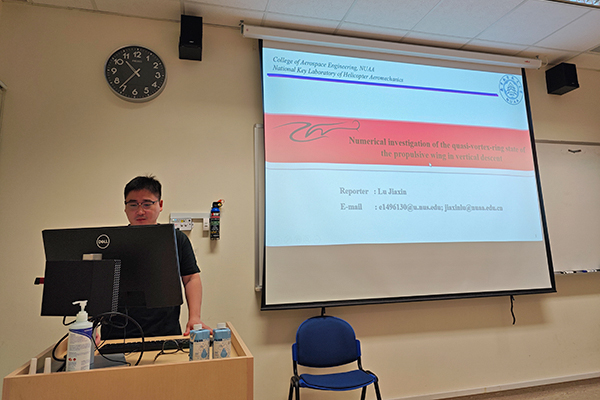
Numerical Investigation of the Quasi-Vortex-Ring State of the Propulsive Wing in Vertical Descent |
| 7 Narch 2025, Friday, 10:30am to 11:00am | Speaker: Mr. Lu Jiaxin, PhD Student, College of Aerospace Engineering, Nanjing University of Aeronautics and Astronautics |
| Venue: Seminar Room 8D-1, Level 8, Temasek Laboratories | Event Organiser Host: Dr. Huang Xin |

ABSTRACT |
A multi-axis propulsive wing aircraft is a new type of vertical takeoff and landing aircraft. When the aircraft descends vertically, it enters a quasi-vortex-ring state (QVRS) similar to the vortex-ring state of the rotor. Based on the computational fluid dynamics method, the sliding grid technique was used to simulate and analyze the QVRS of a single propulsive wing in vertical descent. First, a computational method for the propulsive wing flow field was established, and the variation laws of the aerodynamic forces of the propulsive wing were analyzed. Then, the change in the flow field structure and wake of the propulsive wing was further studied, and the evolution mechanism of the QVRS of the propulsive wing was explained. Finally, recovery strategies for the QVRS and windmill–brake state (WBS) of the propulsive wing were proposed. The simulation results show that when the descent speed is less than the critical speed, the propulsive wing enters the QVRS. The interaction between the propulsive wing wake and reverse airflow provides an aerodynamic amplification of up to 17.3%; thus, the propulsive wing has satisfactory safety in the QVRS. When the descent speed is greater than the critical speed, the propulsive wing enters the WBS and its aerodynamic force is almost zero. The aerodynamic force of the propulsive wing can be increased by increasing the rotational speed of the cross-flow fan. Then, the descent speed of the propulsive wing slows down and the propulsive wing recovers from the dangerous state. |
| ABOUT THE SPEAKER |
 Mr. Lu Jiaxin is currently a PhD student in the National Key Laboratory of Helicopter Aeromechanics and College of Aerospace Engineering at the Nanjing University of Aeronautics and Astronautics, supervised by Prof. Lu Yang. He is engaged in the research of multiphase fluid dynamics of hybrid aerial-underwater propulsive wing vehicles, focusing on the application of propulsive wing in short take-off and landing, vertical take-off and landing, hybrid aerial-underwater, and other special vehicles. Mr. Lu Jiaxin is currently a PhD student in the National Key Laboratory of Helicopter Aeromechanics and College of Aerospace Engineering at the Nanjing University of Aeronautics and Astronautics, supervised by Prof. Lu Yang. He is engaged in the research of multiphase fluid dynamics of hybrid aerial-underwater propulsive wing vehicles, focusing on the application of propulsive wing in short take-off and landing, vertical take-off and landing, hybrid aerial-underwater, and other special vehicles.
|
